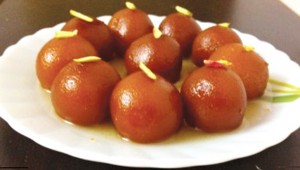Mama’s Punjabi Recipes: Gulab Jamun (Rose Colored Fried Sweet Balls)
Saved under Community, Current Stories, Recipe Corner
Tags: Baytown, Clear Lake, Cypress, Desi news, Greater Houston, Gulab Jamun, Houston, Houston Desi news, India, Indian American community, Indian News, Indians in America, Indo-American News, Katy, Mama’s Punjabi Recipes, NRI, pearland, south asia, South India, Sugar Land, Texas, USA
With the advent of cold weather, it is the season for sweets, nuts and wonderful aromas like this recipe which can fill any dining table for the Holidays. Below is a reprint of Mama’s Gulab Jamun recipe, which is a tasty sweet popular in many Indian restaurants and is especially delightful during the merry winter holiday season. It is reprinted with some additional information and directions.
Invariably, every desi restaurant across the world offers at least these four choices of deserts: chawal ki kheer (rice pudding), ras malai (cheese patties in sweet cream), gajjar ka halwa (carrot pudding) and gulab jamun (rose colored fried sweet balls). You don’t even have to ask what the dessert menu is; these four will be there.
Each of these deserts has a different level of difficulty in preparation; but in my opinion, making delicious gulab jamun is the most difficult. They have to be soft, but not mushy; firm, but not hard and they have to soak in the chaasni (syrup) which should be sweet and just the right consistency, but not thin.
I remember an occasion when a friend was making gulab jamun for a party the next day. She used cold water to mix the dough, though I advised her not to, and then fried the round balls in hot oil. After frying them, she did not put them right away in the syrup; instead she waited till she had fried them all and kept them stacked in a tray, which made them hard as they cooled. Later she let them soak but the gulab jamun stayed hard as rocks! I even tried to steam them to soften them, but no avail. We finally had to throw them away!!
Gulab jamun is made mainly from freshly curdled milk, also known as khoya, and garnished with dried nuts like almonds or pistachios in the middle. The khoya is kneaded into a dough, with a pinch of flour; but these days many people use powdered milk instead as it is easier and cheaper to use. After the balls are fried, they are soaked in a light chaasni (syrup) flavored with green illachi (cardamom); gulab pani (rose water); kewra or kesar (saffron).
Gulab jamun was first brought to India by the invading Persians, and the word “gulab” is derived from the Persian words gol (flower) and ab (water). Jamun is the Hindustani word for Syzygium jambolanum, an Indian fruit that is purple and has a similar size and shape. It is a dessert eaten often at festivals and special occasions like weddings, Eid or Diwali.
Gulab jamun are usually brownish red in color because of the sugar content in the milk powder or khoya. If the sugar is added to the batter, it will get caramelized, giving them an almost black color, and are called kala jamun (black jamun).
Ingredients:
• 4 cups full-fat milk powder
• 1 cup maida (self-rising flour)
• 2 cups bariq chinni (fine sugar)
• 1 cup makhan (butter) – you can also use vegetable oil
• 1 cup pani (water)
• 1 tspn chotti illachi (small cardamom) powder
• Pinch of kesar (saffron) – to taste
Directions:
1. In a bowl, combine the milk powder, self-rising flour then mix in the oil and milk. Knead till it becomes a semi soft dough. Leave aside for at least 15 minutes.
2. To make the chaasni (syrup), in a saucepan, mix in the sugar into the water, then place it over medium heat to boil for 5 minutes and dissolve, then turn the heat off. If you want, throw in the cardamom and saffron for taste.
3. Pour the oil in a wide kadai (wok) and place over high heat then turn to medium heat after 5 minutes.
4. Meanwhile, pinch off a little bit of the dough and make into 3/4 inch round balls in the palms of your hands, placing them on a plate. Coat your hands with some vegetable oil so that the ball will not stick.
5. Gently slide the balls into the hot oil and stir till they are brown all the way around. Take them out and then gently drop them into the chaasni.
6. After all the jamun are made, leave in a bowl with the syrup and serve at room temperature or, for better flavor, serve warm.
MAMA’S TIP OF THE WEEK: DON’T COOK WITH INGREDIENTS RIGHT OUT OF THE FRIDGE!
When cooking, it is best to take the ingredients out of the fridge either the night before or at least a few hours in advance so that they can come to room temperature. If you use them from the fridge, like cold milk or cold water, to make dough for gulab jamun, for example, the atta (flour) will bind together too closely and then the jamun will turn out hard. In the same way, when cooking thinning down daals (lentils) or other curries, cold water will reduce their taste and consistency: it is better to warm the water up before.

Shakuntla Malhotra is a skilled cook of Punjabi dishes made in the old-fashioned style that she learnt as a young woman in her ancestral home in Lyallpur, India (since renamed Faisalabad) before it became part of Pakistan after the Partition in 1947. People have often admired her cooking for its simplicity and taste that comes with each mouthful. Even in her late-eighties, she continues to cook daily and agreed to share her delectable Punjabi vegetarian recipes for future generations.

